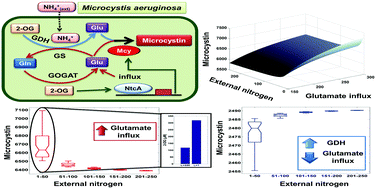当前位置:
X-MOL 学术
›
Mol. Biosyst.
›
论文详情
Our official English website, www.x-mol.net, welcomes your feedback! (Note: you will need to create a separate account there.)
Exploring the role of GS–GOGAT cycle in microcystin synthesis and regulation – a model based analysis
Molecular BioSystems Pub Date : 2017-10-05 00:00:00 , DOI: 10.1039/c7mb00342k Swarnendu Banerjee 1, 2, 3, 4 , Abhishek Subramanian 4, 5, 6, 7, 8 , Joydev Chattopadhyay 1, 2, 3, 4 , Ram Rup Sarkar 4, 5, 6, 7, 8
Molecular BioSystems Pub Date : 2017-10-05 00:00:00 , DOI: 10.1039/c7mb00342k Swarnendu Banerjee 1, 2, 3, 4 , Abhishek Subramanian 4, 5, 6, 7, 8 , Joydev Chattopadhyay 1, 2, 3, 4 , Ram Rup Sarkar 4, 5, 6, 7, 8
Affiliation

|
Toxic cyanobacteria blooms populate water bodies by consuming external nutrients and releasing cyanotoxins that are detrimental for other aquatic species, producing a significant impact on the plankton ecosystem and food web. To exercise population-level control of toxin production, understanding the biochemical mechanisms that explain cyanotoxin regulation within a bacterial cell is of utmost importance. In this study, we explore the mechanistic events to investigate the dependence of toxin microcystin on external nitrogen, a known regulator of the toxin, and for the first time, propose a kinetic model that analyzes the intracellular conditions required to ensure nitrogen dependence on microcystin. We hypothesize that the GS–GOGAT cycle is manipulated by variable influx of different intracellular metabolites that can either disturb or promote the balance between the enzyme microcystin synthetase and substrate glutamate to produce variable microcystin levels. As opposed to the popular notion that nitrogen starvation increases microcystin synthesis, our analyses suggest that under certain intracellular metabolite regimes, this relationship can either be completely lost or reversed. External nitrogen can only complement the conditions fixed by intracellular glutamate, glutamine and 2-oxoglutarate. This mechanistic understanding can provide an experimentally testable hypothesis for exploring the less-known biology of microcystin synthesis and designing specific interventions.
中文翻译:

探索GS–GOGAT循环在微囊藻毒素合成和调控中的作用–基于模型的分析
有毒的蓝藻花粉通过消耗外部养分并释放有害于其他水生物的氰毒素,从而在水体中繁殖,从而对浮游生物生态系统和食物网产生重大影响。为了对人群的毒素生产进行控制,了解解释细菌细胞内氰毒素调节的生化机制至关重要。在这项研究中,我们探索机制事件,以研究毒素微囊藻毒素对外部氮(一种已知的毒素调节剂)的依赖性,并首次提出了动力学模型,该模型分析了确保氮对微囊藻毒素的依赖性所需要的细胞内条件。我们假设GS-GOGAT周期受不同细胞内代谢产物的大量流入所操纵,这些代谢产物可能干扰或促进微囊藻毒素合成酶和底物谷氨酸之间的平衡,从而产生微囊藻毒素水平变化。与普遍认为氮饥饿会增加微囊藻毒素合成的观点相反,我们的分析表明,在某些细胞内代谢方案下,这种关系可能会完全消失或逆转。外部氮只能补充由细胞内谷氨酸,谷氨酰胺和2-氧代戊二酸固定的条件。这种机制的理解可以提供实验上可检验的假设,以探索鲜为人知的微囊藻毒素合成生物学并设计特定的干预措施。
更新日期:2017-11-21
中文翻译:

探索GS–GOGAT循环在微囊藻毒素合成和调控中的作用–基于模型的分析
有毒的蓝藻花粉通过消耗外部养分并释放有害于其他水生物的氰毒素,从而在水体中繁殖,从而对浮游生物生态系统和食物网产生重大影响。为了对人群的毒素生产进行控制,了解解释细菌细胞内氰毒素调节的生化机制至关重要。在这项研究中,我们探索机制事件,以研究毒素微囊藻毒素对外部氮(一种已知的毒素调节剂)的依赖性,并首次提出了动力学模型,该模型分析了确保氮对微囊藻毒素的依赖性所需要的细胞内条件。我们假设GS-GOGAT周期受不同细胞内代谢产物的大量流入所操纵,这些代谢产物可能干扰或促进微囊藻毒素合成酶和底物谷氨酸之间的平衡,从而产生微囊藻毒素水平变化。与普遍认为氮饥饿会增加微囊藻毒素合成的观点相反,我们的分析表明,在某些细胞内代谢方案下,这种关系可能会完全消失或逆转。外部氮只能补充由细胞内谷氨酸,谷氨酰胺和2-氧代戊二酸固定的条件。这种机制的理解可以提供实验上可检验的假设,以探索鲜为人知的微囊藻毒素合成生物学并设计特定的干预措施。



























 京公网安备 11010802027423号
京公网安备 11010802027423号